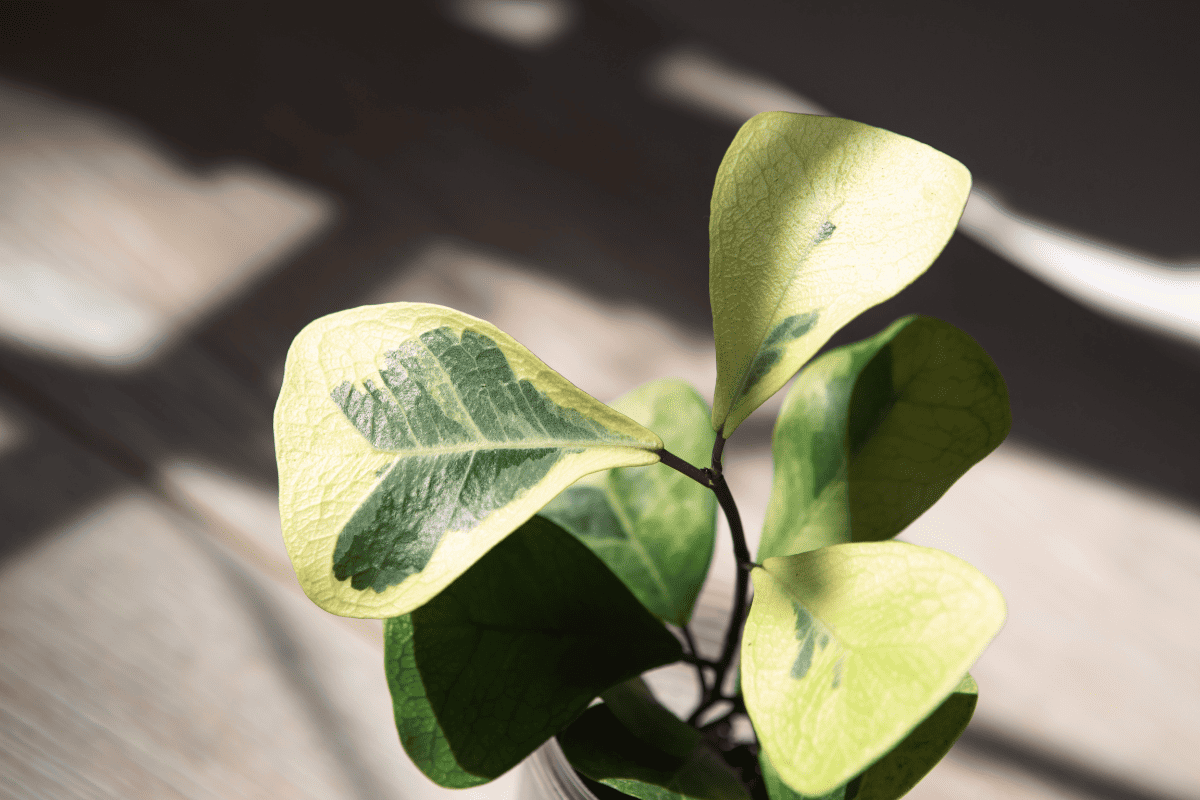Want to learn how to care for the Ficus Triangularis? You’re in the right spot! This article will cover alll you need to know to care for the beautiful (and not so hard to grow) Ficus Traingularis.
Everything I have ever heard or experienced about growing ficus plants is generally not great. They tend to be picky little guys that routinely shed their leaves and require being fussed over like a baby!
Well, I am here to tell you, this ficus is different from its other family members! Let me help you see how you can own one of these beauties and also grow one much easier than you would have ever thought possible!
Table of Contents
Ficus Triangularis History

This post includes affiliate links.
The Ficus Triangularis, also known as the common name Triangle Ficus, is a beautifully unique plant that we’ll be discussing in this post. It is called the Triangle Ficus because the leaves are triangular in shape. It is also known as a Ficus Fig or Triangle Fig or Ficus Triangularis Variegata.
There are plants with dark green and shiny triangular-shaped leaves and there are some with a variegated variety that have cream and green leaves. It is possible, with optimal care, that your ficus could grow to eight feet tall and spread four feet wide! The variegated version is more of a Dwarf Triangle Fig and only grows about four feet tall though.
Native to South Africa, it is usually grown as an outdoor plant. These tropical plants need warm temperatures to thrive. However, you would need to live in either USDA Zones 12 or 13 to grow it outdoors. Because of this, it is most often grown as an indoor plant.
Even though this plant tends to be quite uncommon in the plant nursery industry, you should be able to find one at some point in your search. If you ever do see one at a greenhouse or nursery, you should be sure to grab it! It would be a wonderful addition to your plant collection!
Toxicity
The Triangle Ficus contains sap that can cause irritation and inflammation in the mouth and gastrointestinal tract when ingested. You need to keep this plant away from both humans and pets for this reason.
Ficus Triangularis Care

Here’s how to care for your Ficus Triangularis and a Variegated Ficus Triangularis.
Watering
The Ficus Triangularis enjoys deep watering. Then it should be allowed to dry out before watering again. You should water it only when the top third of the soil is dry. You can always use a moisture meter to ensure you’re watering it at the right time!
This will also depend on the growing conditions. It is possible (depending on where you have your plant located – inside or outside) that watering will need to be done twice weekly during the warm growing season. Less watering will need to be done during the fall and winter.
Do not overwater your Ficus or leave it standing in water. Also, be aware that these plants are sensitive to very cold or very hot water. They should be watered with room temperature to lukewarm water.
Light Requirements
The Triangle Fig loves direct sunlight as long as it is not too intense, which can cause leaf burn. Your plant needs the proper amount of bright light to keep the leaves shiny and in good health.
A south facing window that provides your fig at least eight hours of light a day will provide sufficient light for good growth. If your plant is in a low light spot, the leaves will fade in color and intensity, especially with the variegated varieties.
Leaf drop is also a sign that your plant is not getting enough light. If this happens, you will need to move your plant to a place where it receives sufficient light or use a grow light!
Soil Requirements
This plant requires a rich, well draining potting mix. You can use a standard potting soil or you can mix your own. Using a mixture including equal parts of peat moss or coco coir, pine bark, and perlite or sand will work well also.
Fertilizer Requirements
The Ficus Fig will benefit from using an all purpose liquid fertilizer about every six weeks during the growing season. Be sure to follow the package instructions for mixing it. You will not need to fertilize in the winter months since the growth cycle will slow during this time.
Temperature and Humidity Requirements
Fortunately, your Ficus Triangularis enjoys living in average household temperatures between 60 and 75 degrees F. If temps fall below this (between 55 to 60 degrees F), the growth will slow down.
Keep in mind, however, that you should not submit this plant to temperatures below 55 degrees F. Also, the Ficus does not like a sudden change in temperature.
Having your ficus in a room with slightly above average humidity conditions is ideal. If you need to invest in a small humidifier or use a pebble tray, this will greatly enhance your plants’ growth as it is a tropical plant. A bathroom or kitchen may be a good place to place your ficus for this reason!
Pests and Diseases
The Triangle Fig can be susceptible to aphids, mealybugs, scale, spider mites, thrips, and whiteflies. These pests mostly like to hide on the undersides of the leaves.
If you do identify any of these pests, the first thing to do is to isolate your plant. Once you have identified an infestation of pests, you need to treat it with a proper pesticide or insecticidal soap. Follow the package instructions and treat accordingly.
The most common causes of diseases in these plants are poor air circulation and incorrect watering. Also, the Triangle Fig can be affected by root rot, leaf spot, botrytis blight, powdery mildew, rust, and southern blight. If you suspect a disease, isolate your plant and treat with a fungicide following all label instructions accordingly.
Pruning and Repotting
Typically, a Ficus Triangularis does not need much pruning. You should, of course, trim any discolored leaves or leggy stems to keep the plant looking nice and healthy. Be sure to use gloves when doing the pruning as the sap tends to be irritating to skin.
If the roots of your plant begin to poke out the drainage holes in the bottom of your pot, then it is time to repot it! Choose a pot that is at least one to two times larger than the current pot. Use fresh well-drained soil when you repot as the soil tends to lose nutrients over time.
The best time to prune or report your plant is in the spring time!
Where to Buy
FAQs
Overwatering symptoms include rotten plant sections, yellowing lower leaves, and a softened stem. This is usually caused by too little light or standing water in the pot between waterings. Be sure the plant is never standing in water. This will also prevent root rot.
This plant is a tropical plant, so it needs to have above average humidity. This can be accomplished by placing the plant in a higher humidity room such as a bathroom or kitchen or using a small humidifier or pebble tray beneath the pot.
Normal tap water contains chlorine and other chemicals, so isn’t usually the best for your plant. However, you can use it if you allow the water to sit for 24 hours prior to using it. Fill your watering container with tap water and allow it to sit, then water your plants.
In Conclusion
After reading this, do you see what I mean about this plant not being quite so fussy as other ficus? Maybe you’ve never owned one, but this is one you should try growing. Take a chance! It might surprise you! As always, keep on growing!
If you want to check out our other ficus plant posts, here’s our ficus lyrata (fiddle leaf fig plant) care post, our ficus lyrata “babmino” care post and also our ficus benjamin care post!
